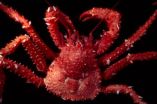(Press-News.org) When looking for new ways to treat aggressive brain cancers, an international team of scientists turned a new leaf and "discovered" the lowly daffodil. A new research study published in the November 2010 print issue of The FASEB Journal (http://www.fasebj.org) offers hope that a natural compound found in daffodil bulbs, called narciclasine, may be a powerful therapeutic against biologically aggressive forms of human brain cancers.
"We are planning to move a narciclasine derivative toward clinical trials in oncology within a three to four year period in order to help patients with brain cancers, including gliomas, as well as brain metastases," said Robert Kiss, Ph.D., co-author of the study from the Laboratory of Toxicology at the Institute of Pharmacy at the Université Libre de Bruxelles in Brussels, Belgium. "We hope narciclasine could be given to brain cancer patients in addition to conventional therapies."
To make this discovery, Kiss and colleagues used computer-assisted techniques to identify targets for narciclasine in cancer cells. The strongest potential candidate to emerge was the eEF1A elongation factor. Researchers then grafted human melanoma brain metastatic cells into the brains of genetically altered mice. Results showed that the injected mice survived significantly longer when treated with narciclasine than those mice left untreated. The researchers believe that narciclasine selectively inhibits the proliferation of very aggressive cancer cells, while avoiding adverse effects on normal cells. Narciclasine could be used in the near future to combat brain cancers, including gliomas, and metastases such as melanoma brain metastases.
"Scientists have been digging in odd corners to find effective treatments for brain cancer for decades, and now they've found one in daffodils." said Gerald Weissmann, M.D., Editor-in-Chief of The FASEB Journal, "It doesn't mean that you should eat daisies or daffodils for what ails you, but that modern medicinal chemistry can pluck new chemicals from stuff that grows in the garden. This is a good one!"
###
Receive monthly highlights from The FASEB Journal by e-mail. Sign up at http://www.faseb.org/fjupdate.aspx. The FASEB Journal (http://www.fasebj.org) is published by the Federation of the American Societies for Experimental Biology (FASEB). The journal has been recognized by the Special Libraries Association as one of the top 100 most influential biomedical journals of the past century and is the most cited biology journal worldwide according to the Institute for Scientific Information.
FASEB comprises 23 societies with more than 100,000 members, making it the largest coalition of biomedical research associations in the United States. FASEB enhances the ability of scientists and engineers to improve—through their research—the health, well-being and productivity of all people. FASEB's mission is to advance health and welfare by promoting progress and education in biological and biomedical sciences through service to our member societies and collaborative advocacy.
Details: Gwendoline Van Goietsenoven, Jenna Hutton, Jean-Paul Becker, Benjamin Lallemand, Francis Robert, Florence Lefranc, Christine Pirker, Guy Vandenbussche, Pierre Van Antwerpen, Antonio Evidente, Walter Berger, Martine Prévost, Jerry Pelletier, Robert Kiss, Terri Goss Kinzy, Alexander Kornienko, and Véronique Mathieu
Targeting of eEF1A with Amaryllidaceae isocarbostyrils as a strategy to combat melanomas
FASEB J. 2010 24: 4575-4584. DOI: 10.1096/fj.10-162263 ; http://www.fasebj.org/cgi/content/abstract/24/11/4575
Scientists turn a new leaf to discover a compound in daffodils that targets brain cancer
New research in the FASEB Journal suggests that narciclagsine, a natural compound found in daffodil bulbs, markedly reduces cancer cell proliferation and migration
2010-11-02
ELSE PRESS RELEASES FROM THIS DATE:
Scientists uncover a genetic switch that turns immune responses on and off
2010-11-02
Scientists are keeping their eye on a new discovery published in the November 2011 print issue of the FASEB Journal (http://www.fasebj.org) that explains what causes some genes to go out of control. Scientists have identified a "cellular switch," called eye transformer, that controls the flow of information from chemical signals outside of the cell to genes in the cell nucleus. This study demonstrates that when eye transformer is turned off, the information pathway it controls (the "JAK/STAT pathway") hyper-activates. Because this pathway exists in humans and is involved ...
Mayo researchers find mortality rates from liver diseases underestimated
2010-11-02
ROCHESTER, Minn. -- Statistics from the Centers for Disease Control and Prevention (CDC) (http://www.cdc.gov/) rank mortality related to chronic liver disease and cirrhosis as the 12th most common cause of death in adults in the U.S. Using a modified definition that includes diseases such as viral hepatitis, liver cancer (http://www.mayoclinic.org/liver-cancer/) and obesity-related fatty liver disease (liver diseases)(http://www.mayoclinic.org/liver-disease/), Mayo Clinic-led researchers have found that liver-related mortality is as high as fourth for some age groups, and ...
MRI contrast agents change stem cell proliferation
2010-11-02
Tampa, Fla. (Nov. 01, 2010) – When researchers tested three different labeling agents on three different stem cell populations to determine what effect the labeling agents had on stem cell phenotype, biological behavior and migration abilities, they found changes in stem cell proliferation depending on the type of contrast agent used.
The team of researchers from Belgium and Spain tested USPIO (ultra small superparamagnetic iron oxide) contrast agents Resovist ®, Endorem ® and Sinerem ® on mouse embryonic stem cells (mESC), rat multipotent adult progenitor cells (rMAPC) ...
Slight change in wind turbine speed significantly reduces bat mortality
2010-11-02
While wind energy has shown strong potential as a large-scale, emission-free energy source, bat and bird collisions at wind turbines result in thousands of fatalities annually. Migratory bats, such as the hoary bat, are especially at risk for collision with wind turbines as they fly their routes in the forested ridges of the eastern U.S. This loss not only impacts the immediate area, but is also detrimental to ecosystem health nationwide—that is, bats help with pest management, pollination and the dispersal of numerous plant seeds.
Since turbine towers and non-spinning ...
Voting-machine-allocation method could reduce voters' wait time by 36 percent
2010-11-02
With a lifelong interest in politics, University of Cincinnati researcher Muer Yang spent the last two years developing a quantitative method for allocating voting machines that could significantly reduce the average wait time of voters.
During the 2004 U.S. presidential elections, some voters waited in lines for more than 10 hours to cast their ballots, and in Ohio, the last vote was cast at 4 a.m., noted Ohio Secretary of State Jennifer Brunner in a public report. Ohio lines in the '06 and '08 elections were still so lengthy that they essentially "disenfranchised" voters ...
Study: Race plays a minor role in forging Facebook friendships
2010-11-02
CAMBRIDGE, Mass., Nov. 1, 2010 -- Race may not be as important as previously thought in determining who befriends whom, suggests a new study of American college students' habits on Facebook. The findings, by a pair of sociologists from Harvard University and UCLA, appear in the current issue of the American Journal of Sociology.
The strongest attraction, the researchers found, turned out to be old-fashioned social pressure. For the average student, the tendency to reciprocate a friendly overture is seven times stronger than the attraction of a shared racial background.
"We ...
King crab distributions limited by temperature in the Southern Ocean
2010-11-02
Invasions of voracious predatory crabs due to global warming could threaten the unique continental-shelf ecosystems of Antarctica, according to newly published findings.
"King crabs are ecologically important predators and form the basis of economically significant commercial fisheries," said Dr Sven Thatje, an evolutionary ecologist at the University of Southampton's School of Ocean and Earth Science (SOES), which is based at the National Oceanography Centre in Southampton.
Thatje and graduate student Sally Hall studied how water temperature influences the distributions ...
Scientists find that evergreen agriculture boosts crop yields
2010-11-02
THE HAGUE (2 November 2010)—A unique acacia known as a "fertilizer tree" has typically led to a doubling or tripling of maize yields in smallholder agriculture in Zambia and Malawi, according to evidence presented at a conference in the Hague today. The findings were central to the arguments of agroforestry experts at the conference, who urged decision makers to spread this technology more widely throughout the African nations most vulnerable to climate change and food shortages, and to think differently about more practical ways to solve the problems that are most pressing ...
At great expense, railroad bypassed first black-founded town in the US
2010-11-02
CHAMPAIGN, lll.— Ignoring topography, efficiency, expense and even their own surveyors' recommendations, regional railroad officials in the mid-19th century diverted a new rail line around New Philadelphia, Ill., "the first town in the United States planned, platted and legally registered by an African American," a University of Illinois researcher reports. The bypass pushed what would have been a fairly straight, even run of railroad tracks from Griggsville, Ill. to Hannibal, Mo., in a wide, hilly arc around New Philadelphia.
The findings, reported in Historical Archaeology, ...
For elderly, even short falls can be deadly
2010-11-02
While simple falls, such as slipping while walking off a curb, may seem relatively harmless, they can actually lead to severe injury and death in elderly individuals, according to a new study published in The Journal of Trauma: Injury, Infection, and Critical Care. As the population continues to age, it is important for physicians and caregivers to be aware of and prepared to deal with this issue, which could significantly impact the overall health and wellbeing of older adults.
In contrast to falls from greater heights, ground-level falls – essentially falls from a ...
LAST 30 PRESS RELEASES:
Low daily alcohol intake linked to 50% heightened mouth cancer risk in India
American Meteorological Society announces Rick Spinrad as 2026 President-Elect
Biomass-based carbon capture spotlighted in newly released global climate webinar recording
Illuminating invisible nano pollutants: advanced bioimaging tracks the full journey of emerging nanoscale contaminants in living systems
How does age affect recovery from spinal cord injury?
Novel AI tool offers prognosis for patients with head and neck cancer
Fathers’ microplastic exposure tied to their children’s metabolic problems
Research validates laboratory model for studying high-grade serous ovarian cancer
SIR 2026 delivers transformative breakthroughs in minimally invasive medicine to improve patient care
Stem Cell Reports most downloaded papers of 2025 highlight the breadth and impact of stem cell research
Oxford-led study estimates NHS spends around 3% of its primary and secondary care budget on the health impacts of heat and cold in England
A researcher’s long quest leads to a smart composite breakthrough
Urban wild bees act as “microbial sensors” of city health.
New study finds where you live affects recovery after a hip fracture
Forecasting the impact of fully automated vehicle adoption on US road traffic injuries
Alcohol-related hospitalizations from 2016 to 2022
Semaglutide and hospitalizations in patients with obesity and established cardiovascular disease
Researchers ‘listen in’ to embryo-mother interactions during implantation using a culture system replicating the womb lining
How changing your diet could help save the world
How to make AI truly scalable and reliable for real-time traffic assignment?
Beyond fragmented markets: A new framework for efficient and stable ride-pooling
Can shape priors make road perception more reliable for autonomous driving?
AI tracks nearly 100 years of aging research, revealing key trends and gaps
Innovative techniques enable Italy’s first imaging of individual trapped atoms
KIER successfully develops Korea-made “calibration thermoelectric module” for measuring thermoelectric device performance
Diversifying US Midwest farming for stability and resilience
Emphasizing immigrants’ deservingness shifts attitudes
Japanese eels, climate change, and river temperature
Pusan National University researchers discover faster, smarter heat treatment for lightweight magnesium metals
China’s 2024 Gastroenterology Report: marked progress in endoscopy quality and disease management
[Press-News.org] Scientists turn a new leaf to discover a compound in daffodils that targets brain cancerNew research in the FASEB Journal suggests that narciclagsine, a natural compound found in daffodil bulbs, markedly reduces cancer cell proliferation and migration


